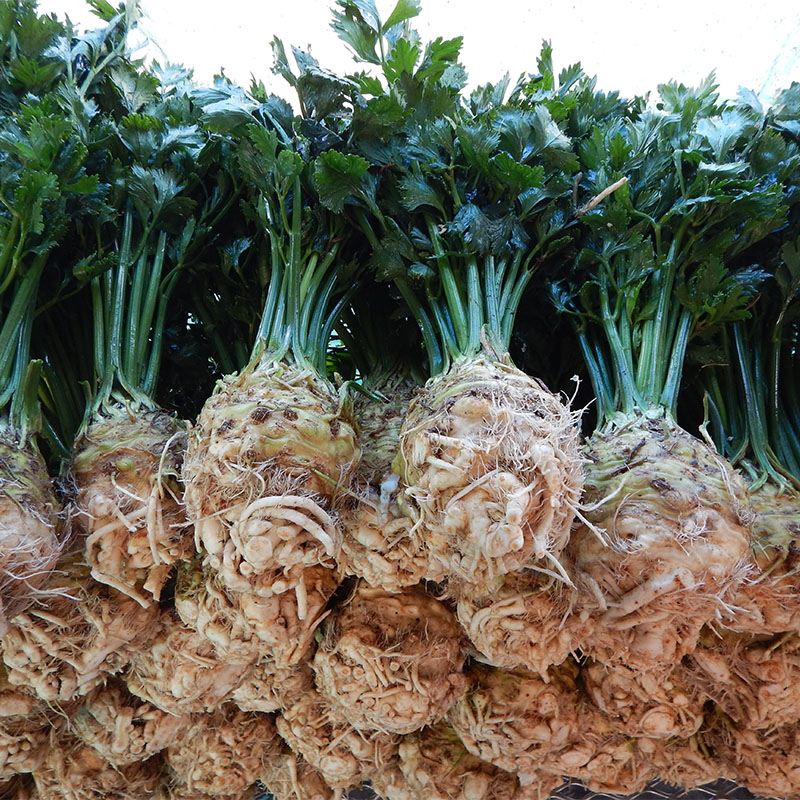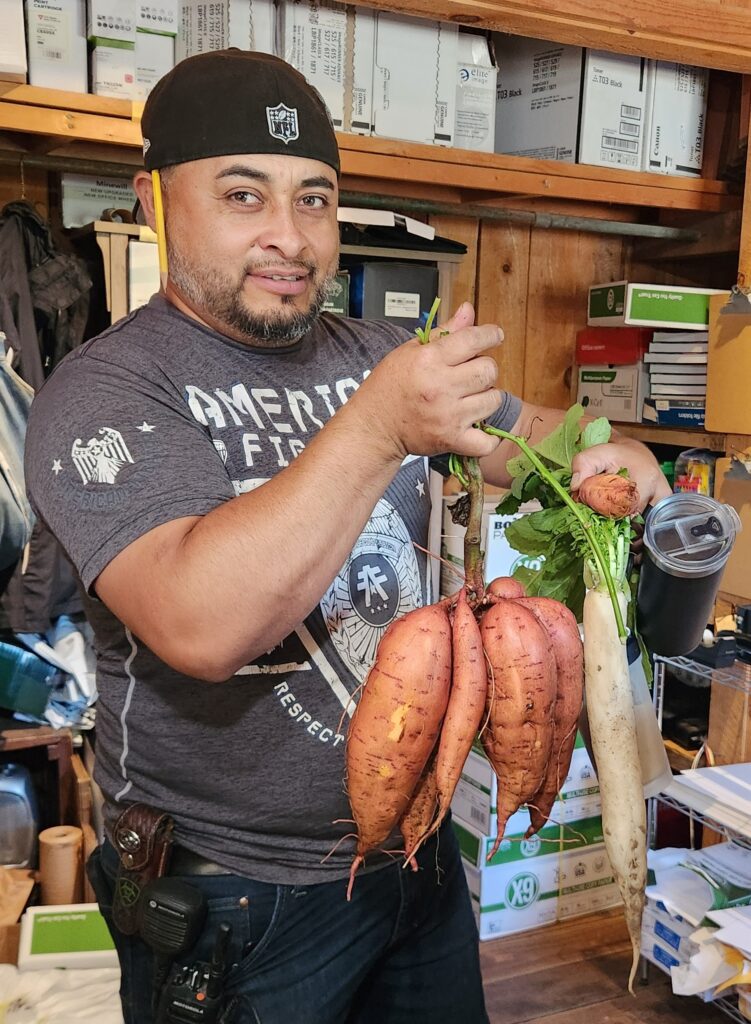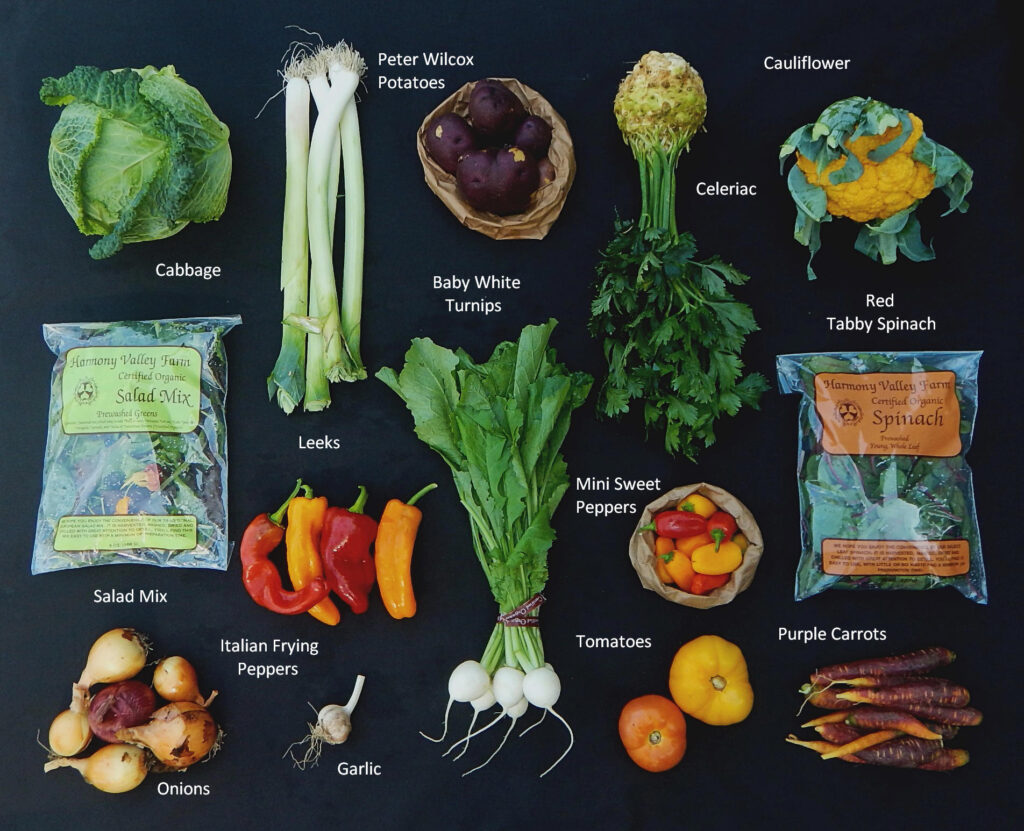What’s In The Box with Recipe Suggestions
Green Savoy Cabbage or Red Cabbage: Both of these varieties are storage cabbages, so don’t feel like you have to eat them all this week! Store cabbage in the crisper drawer of your refrigerator. If you’re going to store it for more than 4-6 days, wrap it loosely in a plastic bag to keep it from dehydrating.
Cabbage Salad with Apples and Walnuts
Purple, Yellow and/or Orange Carrots: Shred carrots to make a beautiful fresh vegetable salad for meals.
Shredded Carrot Salad with Honey Mustard Dressing
5-Minute Ginger Soy Carrot Salad
White, Purple or Yellow Cauliflower or Broccoli Romanesco: Roasted cauliflower is easy to make with the addition of oil, salt and pepper. Once you’ve mastered that, kick it up a notch with some added spices such as Indian-Style Cauliflower or Roasted Cauliflower with Thai Peanut Sauce.
Green Top Celeriac: This is the vegetable with a top that resembles celery and is connected to a knobby, gnarly root. The green top is more fibrous than celery, thus it’s not the best for eating. However, it’s packed with intense flavor so capture that flavor by putting these greens in the pot when you make stock, broth or even just a simple pot of soup. Leave the pieces long so it’s easy to pull them out of the pot before serving the soup. As for the root, it’s a dense, solid vegetable that does need to be peeled. Cut it into quarters to make it easier to handle, then use a paring knife to peel away the outer layer like an apple. The solid, white flesh on the inside is edible and may be eaten raw or cooked.
Maple Bacon Roasted Celeriac and Apples
Italian Garlic: Include garlic in your meals every day and you have a built-in immune system booster!
Celeriac & Roasted Garlic Soup with Parsley Oil
Leeks: Leeks are unique in that we hill them with dirt to keep the lower “shank” portion of the leek white. As such, you need to wash them well before using them as there may be some dirt in between the layers.
Leek Galette with Goat Cheese and Walnuts
Potato Leek Soup with Poblanos and Crispy Bacon
Yellow & Red Onions: It’s best to store onions in a cool, dry location and out of direct sunlight. Both of these varieties are good eaten both raw and cooked.
Orange and Red Italian Frying Peppers: These are the long, slender brightly colored peppers that are packed loose in your box this week. They are sweet peppers appropriate for eating raw or cooked.
Sweet Pepper & Cheddar Clafoutis
Creamy Roasted Sweet Pepper Dressing
Mini Sweet Peppers: These little mini-bell peppers are packed in a brown bag. They are a mix of orange, yellow and red peppers and they are sweet! These are a great snack peppers, or cut them in half and use them as a scoop for your favorite spread such as cream cheese or hummus.
Zesty Mini Bell Pepper Salad with Dill
Peter Wilcox Potatoes: With dark purple skin and gold flesh, this variety is a great example of how nutrients in food benefit our health but also make food taste better! Peter Wilcox potatoes were bred to contain higher levels of phytonutrients including vitamin C and carotenoids. Pay attention to the flavor of this potato as we believe it’s one that will help you distinguish the difference between a “good” potato and one that has “excellent” potato flavor!
Salad Mix: We make our salad mix from a blend of several different baby lettuce varieties combined with baby greens including tat soi, green and red mizuna and red Russian kale. While it’s a gorgeous mix on its own, we added an additional splash of color by adding a few edible nasturtium flowers! Eat the flowers whole or pull the petals off and toss them into the greens.
Mesclun Salad with Goat Cheese, Maple-Glazed Pecans and Maple Dijon Vinaigrette
Mesclun and Tomato Salad with Honey-Lemon Dressing
Spinach: This week we have a beautiful new variety called Red Tabby Spinach. We think it is too pretty to cook with, but you can certainly do so. Try the recipe below!
One-Pot Pasta with Spinach & Tomatoes
Variety of Tomatoes: The tomatoes in your bag may be at various levels of ripeness, so first take a moment to assess the tomatoes. For those that need to be ripened further, store them at room temperature until they are ripe, then eat them!
Tomato Cobbler with Parmesan-Basil Biscuits
Baby White Turnips: This is a salad turnip variety intended for fresh eating. The green tops are also edible and are delicious when simply sauteed in butter along with the turnips! You can use these turnips in any recipe that calls for salad turnips, baby white turnips or hakurei turnips.
Salad Turnips with Ginger & Soy
Vegetable Feature: Celeriac

Celeriac, or celery root as it is also known, can be a bit intimidating if you’re encountering it for the first time. However, as with all vegetables, there’s really no need to be intimidated…it’s just a vegetable! Celeriac is in the same family as celery. The difference is that celeriac is grown for its root and celery is grown for its stalks. While this week’s celeriac has tops, we only harvest them with the tops in late summer or early fall. Pretty soon we will mechanically harvest the entire crop to put them into storage. When we do this, the top is cut off and we store only the root. The stalks on celeriac resemble celery and have a lot of delicious flavors in them, however they are more tough and fibrous than celery and are not usually eaten as you would eat a celery stalk. If you ever get celeriac with the tops still on, don’t throw them away! Their flavor can add depth to a pot of stock or soup.
Now for the root bulb. First, scrub the exterior of the root the best you can. Next, thinly slice away the top and bottom of the root so there is a flat side on the top and the bottom. You’ll probably need to take a little more off the bottom to get past the majority of the roots and get into the more usable bulb portion of the root. At this point, I usually cut the root in half or into quarters, so it is easier to handle. Using a paring knife, carefully trim away the outer skin. Once you’ve removed the outer skin, rinse the remaining piece of celeriac and clean your cutting board if there’s any residual dirt. The inner portion of the root is white, solid, and entirely edible.
Celeriac has a subtle celery flavor that provides a background to soups, stews, and root mashes. It also makes a delicious soup or gratin on its own or combined with potatoes or other root vegetables. It can also be eaten raw in salads and slaws paired with other fall fruits and vegetables. There is a classic French preparation called Celeriac Remoulade which is basically a creamy celeriac slaw. I like to make a slaw based on this concept, but add apples and fresh, chopped cranberries as well as parsley when available. I’ve also noticed more “paleo” recipes are encouraging the use of celeriac as a substitute for starchy potatoes, noodles, etc.
Celeriac stores quite well; thus it is an important part of our seasonal winter diets. It can actually be stored for up to 6 months! Keep it in your refrigerator loosely wrapped in plastic or in the crisper drawer until you are ready to use it.
Short & Sweet Weekly Farm Update

Who else thinks this season has gone by way too fast? This week is our 20th CSA box already, leaving only 10 more this season. This week we harvested our first parsnips and are planning out the rest of the late fall root crop harvests.
Rafael walked into Kelly’s office this morning to show off his new sweet potato and daikon radish. Kelly thought they looked beautiful! Now to decide when they are ready to harvest the whole field. Then they have to be cured in the greenhouse before we can send them on to you!



